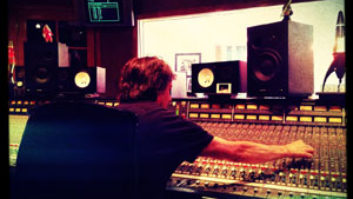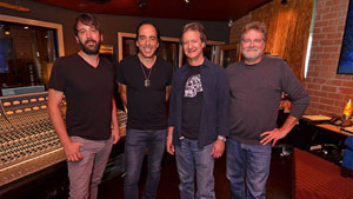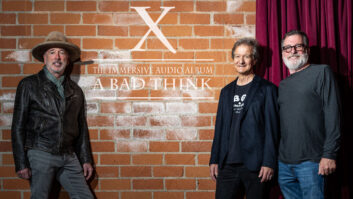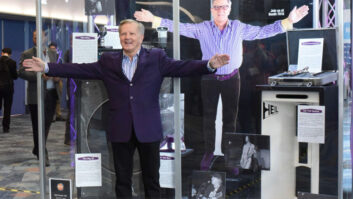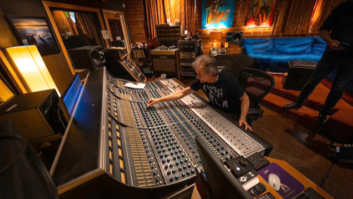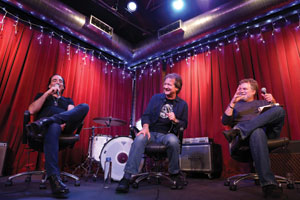
Chris Lord-Alge, Bob Clearmountain and Tom Kenny on the Apogee Studio stage in Santa Monica.
Photo: Alex Oana
Though they both live in L.A., both at the peak of their craft in the rather small world of professional hitmaking mixers, Bob Clearmountain and Chris Lord-Alge don’t run into each other all that often. They’re busy! Four decades in! They’ve each, in their own way, defined a sound, their own sound, at times the sound of a generation. Clearmountain started in the 1970s on a Duke Ellington session and went on to Chic, Bowie, the Stones, Roxy Music, Springsteen, the Pretenders, and a lifelong collaboration with Bryan Adams. Now he mixes a lot of music to picture, in 5.1, along with a lot of records and singles. Lord-Alge came of age about a decade later, with Joe Cocker and Tina Turner and Madonna, on through Christina Aguilera, Tim McGraw, My Chemical Romance, Rihanna and the thunder of Green Day. So many, many more. And they are still doing it! Again, they are busy.
But on a Tuesday night in early June they got together onstage for the first time, in front of 150 people and a video crew, at Apogee Studio in Santa Monica for a freewheeling discussion of Music, Technology, Mixing and Studio Life. They couldn’t be more different in demeanor—Clearmountain a bit more quiet and shy in approach, all the while exuding a calm and assured confidence; Lord-Alge leaning more toward the type-A, with bold declarations and twisted analogies balanced by a reverence and passion for music and mixing. They also couldn’t be more talented or more gracious with their insights. It was a highly entertaining evening.
A video of the event, which was presented by Apogee Electronics, Vintage King and Mix, and produced by Shevy Shovlin of Headroom for Days, is available through any of those companies’ sites. In the meantime, here are some highlights, archived for print. I was privileged to be the moderator. Because Clearmountain grew up in Connecticut and Lord-Alge in New Jersey, we start in New York City, in a different place and a different time…
THE EARLY DAYS
Chris: The birth of what we did was New York. That’s where the attitude was. That’s where the studio scene was for us. One of the great studios is one that Bob actually built, Power Station. For me, in the ’80s, the big studios were Electric Lady, Power Station, A&R, the classics.
Bob: What about Unique?
Chris: Yeah, right, where I worked was a toilet on the seventh floor that became a studio. You really had to suck it up in New York because it wasn’t glamorous. But the energy was there. Where we cut our teeth was all about the City, and I’ve tried to keep that going in this fine establishment we call Los Angeles. Bob: I was in a couple of pretty bad bar bands growing up. One of them broke up while we were in the studio doing a demo, and I thought, ‘I like this.’ So I started hanging around Mediasound, and I kept bugging them, every week, telling them I would be good at this. They eventually hired me, probably just to stop me. I showed up one day as a runner. I did two deliveries, and I come back and they were looking for me. It had been two hours. They tell me they don’t need a runner, they need an assistant. ‘Get into the studio!’ And it’s Duke Ellington.
ON VARIETY
Bob: I grew up pretty much on British rock, with a bit of Southern rock and West Coast rock. Then I was thrown into R&B music—the first sessions I did were with Kool & the Gang and Ben E. King and music like that. Jingles in the day and R&B at night. It was an education. Later on, I went back to rock when Power Station opened, and it was that groove of R&B, the bottom end of bass drum and bass, combined with the rock stuff, that came together and was successful for me. Chic was a jazz band originally. Nile Rodgers was friends with Jimi Hendrix, and so he was into rock while Nile was more into jazz. Then they’re listening to all these disco records and they say, “Wait a minute, we can do that better than them.” And they did. I just did what they were doing, which was combining rock and jazz and R&B and trying to come up with some new kind of sound.

An aerial view of the Deconstructed event at Apogee Studio, where tastemaker KCRW public radio hosts regular performances for broadcast, mixed live by Bob Clearmountain.
Photo: Leslie Mendez
Chris: There are no genres. There’s one. I like popular music, which they shortened to Pop and it came to mean Top 40. But I like music that is popular. That means people listen to it. I want the widest audience I can get. I want breakfast with Mastodon, and I want to have dinner with Dylan Francis. I want to go left to right, from country to rock in one swoop of the fader. I want an 808 kick to the left and a steel guitar to the right. I don’t care. All day and all night, keep it coming.
ON TECHNOLOGY
Chris: Technology is like a four-way stop sign: Pull up and let the other guy go first. I don’t embrace it until it solidifies, as long as what I have is working. I’m not opposed to new technology, and I’ll test drive it. But I’m not changing gears every time the software update light comes on. Music is not based on speed, it’s based on style.
Bob: I’m a big fan of whatever works for whoever is working the technology. I’m comfortable mixing on a SSL analog desk; other people are comfortable mixing in the box. Whatever gets you that thing you’re trying to get in the easiest way while having the most fun. For me, the idea of sitting in front of a computer and a mouse and trying to mix a record that way…I feel bad for people who have to do that [crowd laughs]. But that doesn’t mean mine is the best way to do it. I’ve heard plenty of records that have been mixed entirely in the box and they sound fantastic. They have a great feel, with depth and everything you need for a great-sounding record. It’s not about the technology, it’s what you’re comfortable with.

Chris Lord-Alge: “We’re all musicians, and I don’t think we trust anybody in the studio who isn’t a musician. When you work with musicians, they can smell you out if you’re not one of them. Like a rat, like a spy. If you don’t speak their language, they can tell.”
Photo: Alex Oana
Chris: It’s all your fault that I mix on an SSL, because I wanted to be you! At the time we started, that was the machine to win the race with. An SSL is like a piano, and you can’t play a piano with one finger. It takes your whole mind and body. That’s our way. But it’s a personal thing. It’s how you translate what you hear to what you can get. The newest technology in digital recording simply helps us connect the old world with the new world. We can’t replace the old gear, but we can sure speed up the process of how we get it. Yes, I have plug-ins with my name on them, but it took awhile to get close enough. Plug-ins are emulations, but they have gotten really good.

Bob Clearmountain: “Mixing goes through stages, and you get a feel for it over different times. In the ’80s, I was always putting heavy guitars through harmonizers to get that phasing sound. Then I stopped because it wasn’t that cool anymore. But you don’t necessarily realize that while it’s going on.”
Photo: Alex Oana
Bob: Sometimes I feel bad for people who have only experienced plug-ins. The plug-ins emulate what we used to do, but what was fun back in the old days was actually figuring out how to get tape machines and various gadgets in the studio that weren’t designed to do a certain thing, to do a certain thing. That was the best part.
Chris: The pain, the journey is everything. The best effect of yours that I tried to copy was that bouncing delay on “Let’s Dance.” It sounded like a frickin’ ricochet rabbit going off in the distance. That wasn’t a preset on Echo Boy, you know. [Laughs] It was a couple of tape machines and a couple of hours to get it right.
Bob: Actually it was a couple of minutes on the Studers. [More laughter.] But it was really fun to come up with this stuff. I’m not sure that it’s any more creative; I’m not going that far. I’m just saying that it was a lot of fun.
ON MIXING
Bob: I can put on a record and listen to a song once through. I’m not going to play it twice, or 30 times, in a row. But when you’re mixing you can do that, and you don’t really get sick of it because it’s a different part of the brain. It’s a different type of listening, and the trick is to combine the two. That’s one of the challenges—to be able to sit there and play things over and over and over, little sections at a time, and somehow listen to the big picture as if you’re sitting in your living room listening to it for the first time. That’s what takes quite a bit of practice and skill. I think what happens is that a lot of people focus so deep on the specific bass sound or guitar sound that they don’t listen to the whole. I will solo things, but just briefly, to find out exactly what they’re doing. But when mixing, I leave everything in all the time, listening to the relationships between the instruments, which seems to me more important than the individual sounds.

Clearmountain’s current assistant, Sergio Ruelas, mixed the recorded event through a Neve 8068 in the control room.
Photo: Alex Oana
Chris: Today you have no time to get a mix done. When the artists do show up you might get 45 minutes to get it done, and then it turns out to be your best mix. American Idiot was like that. A couple others were like that. But when the clock is ticking and you have to make a miracle happen with 197 tracks, you work completely without thought. It’s a survival thing and you make it happen.
ON MIXING, PART 2
Bob: I was recently mixing an album for Bryan Adams while he was on tour, so we stream through this service called Nicecast. Sometimes, when the hotel didn’t have a fast Internet connection, he’d go to a Starbucks downstairs, put on headphones and have a cup of coffee. We’d get on iChat, and he types messages like, “The guitar in the second verse should come up.’ We’re mixing a record from a Starbucks in Berlin! Then there was a project with Barenaked Ladies, where they’re each in their own homes in Toronto with their families. I have four or five guys on iChat typing away, listening on Nicecast. They were having so much fun; they said they’ll never mix an album any other way. They would send me a suggestion and I would do it. To them it was like typing commands into their Bob Clearmountain Mixing Computer. [Much laughter] It can work really well if you can get a rhythm going.
ON THE MAGIC
Bob: This studio where we are right now was just a warehouse, storage. I went to Betty [Bennett, his wife, owner of Apogee] and said, “You know, this would make a cool studio space.” And she did it, she made it work. I have had this idea in my head since the 1970s when I worked on a Kool & the Gang album. They recorded the basic tracks live, in front of an audience, then overdubbed it as if it were a studio album. It was called Light of Worlds. I thought, “What a great concept! A studio album with basic tracks done live on a stage for an audience.” This was designed with that in mind. It’s a recording studio, but we put in a stage. Of course, since then KCRW thought it would be great for radio shows, so we added lights and P.A., and now about once a month we do radio shows with a live audience of about 150 to 200 people.

Clearmountain’s former assistant, Brandon Duncan, mixed the house.
Photo: Alex Oana
Chris: To me, the ultimate is to be in the control room at the helm and you’re cutting a band live, and the shit going down is just ridiculous. The interplay. There’s an all-star band and you’re elbowing the guy next to you, saying, “Huh, did I tell you this would be amazing?” We only really mix now, but some of the greatest sessions I ever did were live tracking dates where you see that moment when a demo transforms into a master. Just the synchronicity of a real band with really good players.
